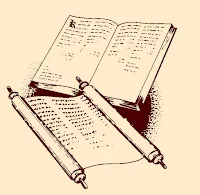Jehovah God formed man from the dust of the ground, and breathed into his nostrils the breath [Hebrew neshamah, Strong's Hebrew #5397] of life; and man became a living soul [Hebrew, nephesh, Strong's Hebrew #5315]. -- Genesis 2:7.
(1) It has been claimed by some that the Hebrew word often transliterated as neshamah, translated "breath" in most translations of Genesis 2:7, corresponds with pneuma (Strong's #4151) of the New Testament Scriptures, that it is the soul common to all human beings, that it is immortal and that neshamah does not apply to lower animals. It is further claimed by some that nephesh, translated "soul" in most translations of Genesis 2:7, corresponds with psuche (or psyche) of the New Testament scriptures, that nephesh applies to all living creatures, animal and human. Some thus clarim that the neshamah is immortal and cannot die while the nephesh is not immortal.
(2) What do the scriptures themselves actually show? Is neshamah only used of humans? Is it immortal? Is it an entity that continues to have conscious existence after the death of the body?
(3) The first of occurrence of the word neshamah in the Bible is at Genesis 2:7, and in this scripture we can see its meaning: "And Jehovah Elohim formed Man, dust of the ground, and breathed into his nostrils the breath [neshamah] of life ; and Man became a living soul -- nephesh]." (Genesis 2:7, Darby) We learn here that the neshamah -- breath or force of life -- is not the nephesh, but that it is a component of the nephesh. Two elements make up the nephesh as described in our text. The body (from the dust) + neshamah (force or spark of life from God) = living nephesh. God was not placing an immortal entity in the dust from the earth, but he was supplying the energy or force that causes sentiency -- a living soul.
(4) Its next occurrence is in Genesis 7:21,22: "And all flesh that moved on the earth expired, fowl as well as cattle, and beasts, and all crawling things which crawl on the earth, and all mankind: everything which had in its nostrils the breath of life [neshamah], of all that was on the dry [land], died." Here we find that neshamah is applied to lower animals, so if it is an immortal entity that continues to live after death, we would have to believe that the lower animals also possess such immortality.
(5) That the Hebrew word neshamah is used in the sense of force or power, especially as the force from God, can be seen from its usage in the following scriptures: 2 Samuel 22:14-16; Job 4:9; 37:10; Isaiah 30:33. This word (neshamah - Strong's #5397) is often used in connection with and interchangeably with the Hebrew word ruach (spirit - Strong's 7307): Genesis 6:3,17; 7:15;22; Job 27:3-5; 34:14,15; Isaiah 42:5. It is this life-force, represented in the Hebrew words neshamah and ruach, that returns to God who gave it when the nephesh no longer lives, both for animals and humans. The fact that the scripture says it "returns" to God shows that it is not a living entity, else we would have to say it was a living entity when God gave it, thus that it was alive before becoming human. -- Genesis 7:22; Deuteronomy 20:16; Joshua 10:40; 11:11,14; 1 Kings 15:29; 17:17; Job 34:14,15; Psalm 104:29; 146:3,4; Ecclesiastes 3:18-22; 12:7. -- See our study on The Spirit That Returns to God
(6) The idea that the neshamah is immortal is based on the Jewish fables, one of which claims that the nephesh is the soul breathed into the human body, and the soul, being from God is eternal. The Jews apparently adopted this idea from the Greeks, although other earlier cultures may have had influence in this direction. Although the Jews blended Greek philosophy with the Bible, actually the Bible itself never speaks of any such idea. Evidently, this belief crept into Christianity very early, although we find nothing about such in the faith once delivered to the saints as found in the Bible. -- Titus 1:14.
(7) Never is the neshamah spoken of in the Bible as a living entity that continues to live after the body dies, or that it possesses immortality -- a sentiency that cannot die. The idea has to be read into the scriptures.
See also:
The Occurrences of Neshamah (Breath)
(Appendix 16 from The Companion Bible)
(Appendix 16 from The Companion Bible)
The Use of Nephesh in the Old Testament
(Appendix 13 from The Companion Bible)
(Appendix 13 from The Companion Bible)
Other Related Studies:
By Ronald R. Day, Sr.; Restoration Light (ResLight) Bible Study Services (RLBible)
*********






No comments:
Post a Comment